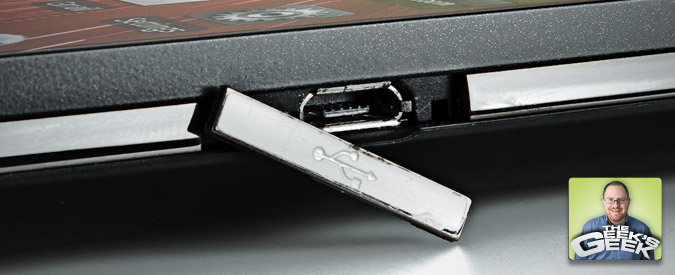Down With Port Flaps and Covers! Keep My USB 3.0 Ports Blue!
School guidance counselors always tell their students "don't hide your light under a bushel." Let's put them in touch with LG, HP, Samsung and all the other interface-ashamed OEMs who bury their ports under giant rubber doors or deliberately mislabel them for "aesthetic reasons." The more plugs your product supports, the more freedom your users have to attach other devices and make the most of them. So why on earth would you seal the connectors behind a wall like the victim in an Edgar Allen Poe story?
Lately, we've seen more than our fair share of phones and notebooks afflicted with port doors. From the Samsung SF310, which places two USB ports and an HDMI connector under a springy door, to the LG Revolution, which annoyingly positions its mini-HDMI out and microUSB ports under a rubber flap, this senseless epidemic has to end. We spend more time fighting these flaps than actually plugging things in.
OEMs have two terrible excuses for their port propriety: safety and aesthetics. The first argument assumes that by covering connectors, we're protecting them from damage. This argument might fly on fully rugged notebooks being taken into war zones, but it makes no sense on mainstream consumer laptops such as the Samsung SF310 or business portables such as the Lenovo ThinkPad X1. These notebooks aren't nuclear submarines that need to batten down the hatches, and your living room is not part of The Hunt for Red October. And if rubber doors provide such great protection, why do these notebooks only cover a few of their ports while leaving the others exposed?
Even lamer, companies claim that hiding ports behind plastic or rubber doors is more attractive to users. Really? When is the last time you were hanging around Best Buy and heard someone say "I'd buy that notebook if only it had fewer holes in the side?"
All technology is beautiful and deserves to be shown off. I want a translucent notebook chassis just so everyone can see I have a Core i7 inside. I need a loud, clicky keyboard with so much tactile feedback that the keys jump up and punch me in the face after each stroke, just to remind me I'm touching a powerful machine. A pox on quiet fans and passive cooling; I want my system to blow small animals across the room at gale force speeds, just so I know it's working.
Ports are particularly pulchritudinous, because they show us that we're using a device pregnant with possibilities. HDMI-out allows us to connect to a TV or large screen monitor, while VGA gives us backward compatibility with millions of old-school projectors and monitors. USB lets us attach to external storage, pointing devices, scanners, monitors, even refrigerators and rocket launchers. On phones, USB lets us charge or exchange data directly with a computer.
An even more horrifying trend than simply hiding ports is dyeing them the wrong color, as we've seen on numerous USB 3.0-enabled systems. Ever since the first SuperSpeed USB compatible-systems shipped last year, we've been able to identify their USB 3.0 ports by the light-blue plastic that surrounds the connectors. However, it turns out that this light-blue plastic is just a recommendation from the USB Implementer's Forum, not a hard requirement.
Sign up to receive The Snapshot, a free special dispatch from Laptop Mag, in your inbox.
"The Blue (Pantone 300C) color used to identify SuperSpeed USB ports is a reference guideline within the USB 3.0 specification," USB-IF President Jeff Ravencraft told us. "It is an option and not a requirement for companies to use that Pantone color."
Unfortunately, we can't rely on the kindness or good sense of notebook vendors. Samsung uses black USB 3.0 ports on its Series 9 notebook and then hides them behind a door, while HP stealthily places two black USB 3.0 connectors on the Pavilion dv6t, apparently because they both think the blue color will clash with their chassis.
Give me a break, Samsung and HP! You should wear your Pantone 300C colors proudly, because USB 3.0 is theoretically 10 times faster than USB 2.0. Even if I had a USB 3.0 port installed in the middle of my forehead, I wouldn't try to hide it. I would tattoo a light-blue box around it so all my friends would know that they could plug an external SSD into me and transfer data to and from my cerebral cortex at over 200 MBps.
You have to be proud of your ports.





